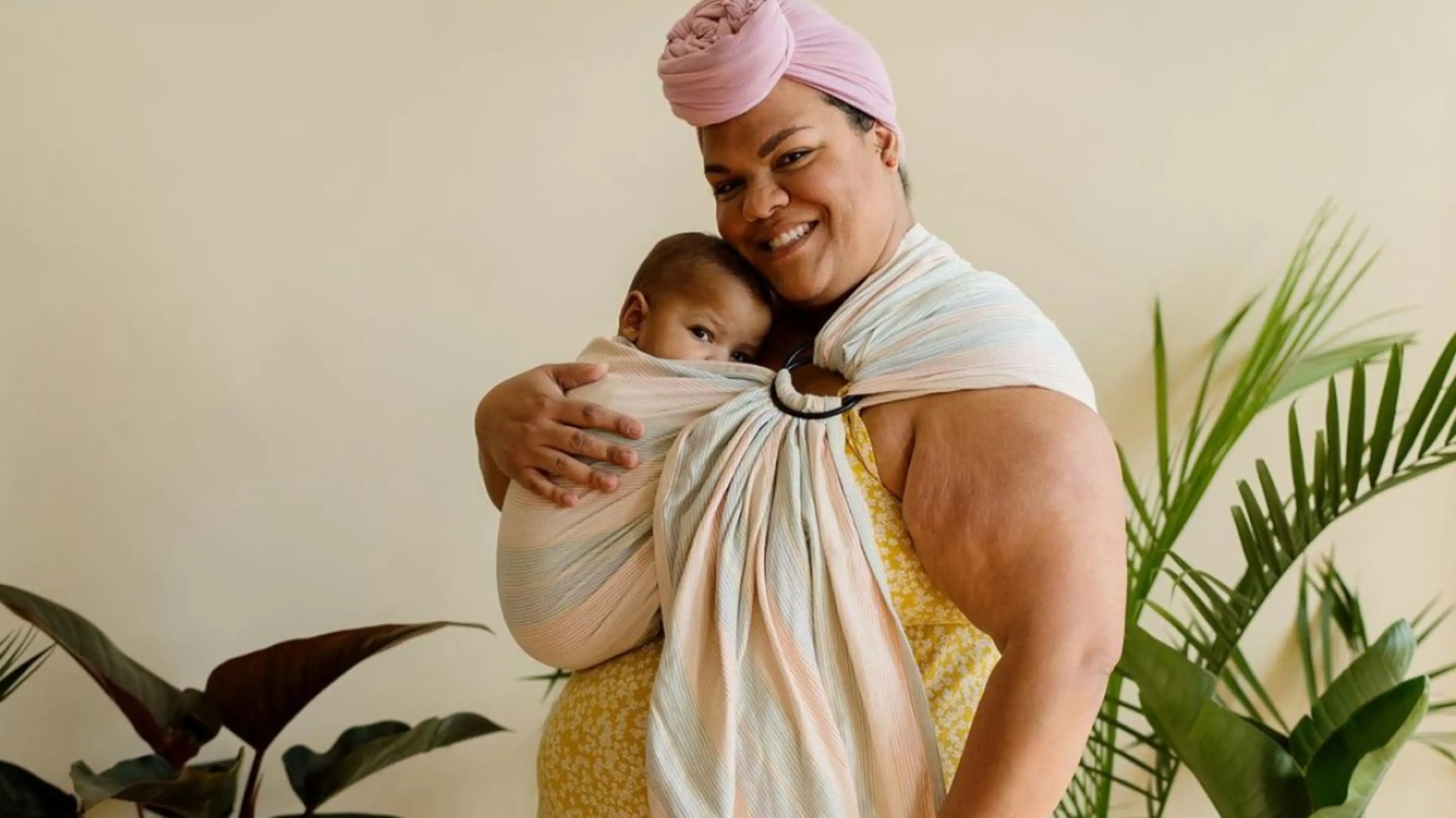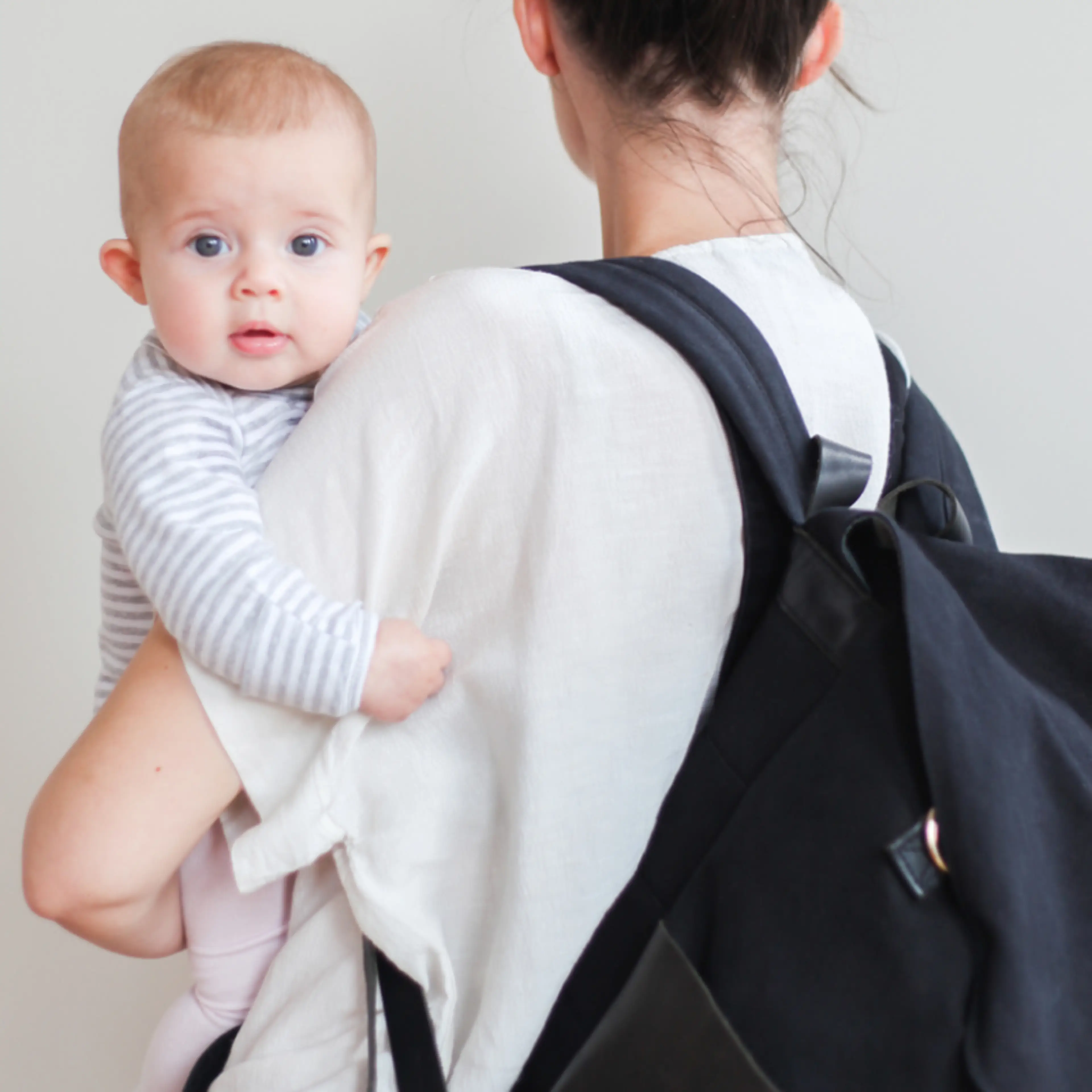TLDR: Babywearing has tons of benefits, but if you aren’t using the right carrier, it can be hard on your postpartum body. Two maternal health experts give their advice for figuring out the right fit, what to do if your carrier isn’t comfortable, and how to find the right baby carrier for you.
Having your hands free as a mom is invaluable, and it’s one of the many benefits of babywearing1 . Luckily, there are plenty of babywearing products on the market that let you keep your little one close while freeing up your hands to go about your day. Whether you’re caring for other kids, working, shopping, or doing something for yourself, babywearing helps you get more stuff accomplished while keeping baby happy.
As great as babywearing is, it’s important that you know how to do it correctly, get the right fit, and find the right baby carrier for you, otherwise you could be risking your posture and ergonomic health, especially if you recently gave birth.
To get the scoop on the good, bad, and best in all things babywearing, we sat down with two maternal health experts who also happen to be moms: Dr. Deb Dlug, the founder of Well Adjusted, LLC2 , and Janelle Gibbs3 , a postural alignment specialist. We got their best advice on getting the best fit for your back and their opinions on the best baby carrier for safety and comfort.
Think about Posture and Ergonomics
If you’re new to babywearing, it’s important to be mindful of your body before starting. For mothers who just gave birth, remember your body recently went through a huge transformation. You not only grew a baby, but you also developed a new organ—the placenta—at the same time. Gibbs encourages new moms to give themselves grace at this time: “Your body isn’t where you left it and it isn’t going to bounce back in just a few days.”
With other postpartum concerns and healing to consider, improper posture can make certain postpartum symptoms worse. Incorrect babywearing can exacerbate some conditions, so if you’re a new mom dealing with one of these, get the all-clear from your doctor before babywearing:
Neck pain
Back pain
Damage to your cesarean scar
Do a Wellness Check-in Before Babywearing
Wearing a baby may seem like it’s nothing but beneficial, but there are a few things you need to keep in mind in terms of your body, your baby, and the carrier you choose before you dive in.
“Wearing a baby is very demanding on your body,” Gibbs says. “If your posture is already compromised, this can lead to a lot of pain and discomfort down the line. This is the last thing a sleep-deprived mom needs.”
Before babywearing:
Make sure you have the right baby carrier size: Take note of your baby carrier’s weight measurements. The best baby carrier for your frame and the size of your baby may be different than someone else’s. (This is especially important if you get a hand-me-down wrap or carrier.)
Know your baby: You don’t want to rush into wearing your baby in the forward position or on your back until they have good head control. You also want to make sure their hips are positioned safely.
Check your posture: Do you have good or bad posture? If you’re the one who’s going to be wearing the baby, consider what your posture looks like to begin with. Wearing a baby is very demanding on your body. If your posture is already compromised, this can lead to a lot of pain and discomfort down the line.
Consider time: Think about how long you want to wear your baby and make sure the carrier you choose can safely accommodate your little one for an extended time—while also being comfortable for you.
Signs of the wrong baby carrier fit
If you aren’t wearing the best baby carrier for you, there are going to be a few telltale signals:
Aches and pains
Muscle strain
Inability to stand up straight
Straps sliding down
Adjusting the straps doesn’t help your comfort level
One shoulder is lower than the other (check the mirror!)
Misalignment (close your eyes and bring your feet together—notice a shift in body weight?)
How to Fix Posture Issues
If your wellness check-in and first attempts at babywearing reveal you have posture issues, don’t panic. There are things you can do to strengthen your back and correct your posture so you can continue babywearing pain-free.
Make sure the weight is evenly distributed.
Ensure your shoulders, hips, and feet are working as well as possible before and while wearing a baby.
Exercise proper breathing before, during, and after babywearing. Using your diaphragm correctly helps activate your core muscles.
Practice basic yoga poses like child’s pose, cat/cow, and bringing your arms over your head with gentle side bending. These can help open your chest, expand your ribs, and move your pelvis. (All excellent for babywearing!)
Exercises to Strengthen Your Body for Babywearing
Postural alignment therapist Janelle Gibbs recommends a variety of exercises that can strengthen your spine and keep your posture aligned if done regularly so you can wear your baby with ease and safety.
Arm Circles
Stand facing a mirror with your feet pointed straight ahead. Place your fingertips into the pad of each hand and point your thumb straight out. This hand position, called the “golfer’s grip,” is imperative to do the exercise correctly. Squeeze your shoulder blades together backward and bring your arms out to your sides at shoulder level.
With your palms facing downward, circle up and forward for 40 reps. With your palms facing upward, circle up and back for 40 and repeat.
Remember to keep your feet straight and your shoulder blades squeezed together
Hip Lift
Lie on your back with your feet on the floor.
Cross one ankle/foot over to the opposite knee, just above the knee.
Lift the foot that’s still on the floor up until your calf is parallel to the ground and the knee is bent at a 90-degree angle.
Relax your shoulders and put your arms out to the sides, palms up.
As you pull the knee with your ankle on it toward you, press the other knee away from you.
Hold this position for one minute, then switch sides and repeat.
Airbench
Stand with your back against a wall with feet and knees hip-width apart and feet pointed straight.
Walk your feet away from the wall while sliding your body down at the same time. You will be “seated” in an invisible chair, with your knees bent to 105 degrees. Your hips are just slightly higher than your knees; your ankles are slightly ahead of your knees. Your lower back should be completely flat against the wall. Your arms can hang down to your sides, or rest your hands gently on your lap.
Hold for 2 minutes. Keep the weight in your heels, and don’t press forward on your toes.
Foot Circles
Lie on your back with one leg extended and the other leg bent and pulled up toward your chest.
Clasp your hands behind the bent knee.
Keep the foot on the floor pointed straight up toward the ceiling and your thigh muscles relaxed.
Circle the lifted foot one way for 40 times, then reverse direction for the same number of reps. Make sure the knee stays absolutely still with movement coming from the ankle and not the knee.
For the point/flexes, bring the toes back toward the shin to flex, then reverse the direction to point the foot forward 40 more times.
Switch legs and repeat.
If you try the adjustments above and you don’t feel relief, it might be time to bring in outside expertise. A chiropractor or perinatal fitness instructor can be a great resource for hands-on support to help you course-correct your alignment and find relief in your babywearing.
How to Choose the Best Baby Carrier for You
When making any decision for your baby, safety is always top of mind. Unfortunately, in the case of wearing a baby, buying the baby carrier your bestie uses or the one you saw on social media may not work for you. If it doesn’t fit your lifestyle, frame, or baby correctly, it's not right for you.
Dr. Dlug advises that, beyond ergonomic considerations, when looking for the best baby carrier you should also factor in the following:
How much does your baby weigh?
How old is your baby?
When do you want to use a babywearing device? While grocery shopping, hiking, walking, cooking, or breastfeeding (yes, that’s a thing)?
How long do you want to wear a baby?
It’s important to position your baby correctly in the carrier to prevent injury or pressure. As with anything for little ones, there’s a lot to consider.
In terms of what baby carriers are best for you and your baby, here are a few well-known and respected options for you to consider in your search:
Solly Baby: buttery-soft, breathable, and perfect for every season
Ergobaby: versatile to fit all different body types
Baby K'tan: an easy-to-use wrap
Boba Wrap: the no-frills baby wrap
Baby Bjorn: the OG baby carrier, the mini is great for newborns
Remember, babies can grow quickly, and it’s perfectly normal to need to change baby carriers at one point or another. You also don’t have to wear your baby for hours at a time. A few minutes of babywearing per day can increase how long you wear your baby later on. Just make sure you’re paying attention to signs of problems or a bad fit.
“Listening to your body is key,” Gibbs says. “If the pain that you’re experiencing is too much, then it is time to go back to the drawing board and figure out what the pain is telling you.
If you struggle with babywearing, know that you are not the first. It’s important to find a good support system during this journey. As Dr. Dlug says, “Don’t be afraid to ask for help!”









